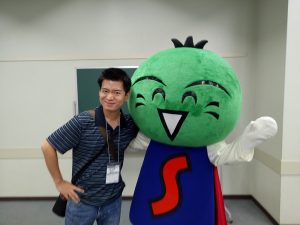先週の火曜日(9月26日)に白井研究室の4年生と私は第22回日本バーチャルリアリティ学会大会で論文を発表するために、四国の徳島へ向かいました。私達は新横浜駅で合流して、新幹線を新神戸駅まで乗って、徳島駅へバスで向かいました。遠征チームのメンバーは6人です:私と4年生の望月宥冶、浅野隆弥、渡邉翔、山口聖也、そして武田竜平。今回は私は初めて日本の関西地域へ行くので、楽しみでしたし、緊張しました。
今回私が展示したプロジェクトはProject JARVISです。プロジェクトのチームメートはJARVISのメインプログラマー:山口聖也です。Project JARVISは最新世代のメガネが要らない多重化可視化技術:ExFieldを使用しています。この研究は白井研究室と日本の会社:富士通アドバンスドエンジニアリングとの共同研究で作成した作品です。VRSJで展示したのは不完全バージョンでしたが、体験者達はProject JARVISを楽しんでいました。
私は今回Project JARVISの展示以外では皆さんの発表のビデオを撮ったり、自分の研究のインスピレーションを得るために様々な研究作品を見ました。VRSJは日本国内で有名なバーチャルリアリティの学会なので、沢山の高水準な研究があります。例えば:ビデオからコントローラーで体験者に触覚フィードバックを与える技術、体験者が敵からダメージを受けた時に電撃としてフィードバックを受ける技術、そして食べられるトラッカー:「食べられる再帰性反射材による食べられるARマーカーの提案と試作」等がありました。それ以外の展示は企業からの最新製品です。その中に一番印象深い製品は日本バイナリー株式会社からの8K HMDシステムです。
Rex here, here to give everyone an update of what I have been up to. Just recently I have participated in the Japan VRSJ conference held in Tokushima at Kansai Japan. This is the first time for me to travel to Kansai and also the first time to go on a trip without my mentor Shirai-sensei so naturally I was both nervous and excited at the same time.
This time the project that I was involved in was Project JARVIS, the newest version of ExField. This project was a joint research between Shirai-lab and Fujitsu Advanced Engineering. Despite of the team only showing a partially incompleted version of Project JARVIS, we received relatively good comments and remarks from the visitors. Other Shirai-lab projects that were exhibited alongside with Project JARVIS is the Real Baby Real Family team.
Aside from attending the exhibition as an exhibitor, my other duties involve taking photos of Shirai-lab members’ presentations and check out researches and products in order to get inspiration for my own research. Luckily for me VRSJ is a very famous conference in Japan thus colleges from all over Japan exhibited their newest researches here. Some of the interesting researches include: Edible AR tracker that were meant to be put into food to track their positions, a system that automatically delivers electric shocks to players once they received damage from VR opponents, and a system that automatically generates haptic feedback to VR controllers from videos depending on the detected ground condition in the video (if there is a hole on the floor inside the video, the VR controller will shake violently once the car passes over the hole). All in all I got many new ideas from the many researches and am glad to be here at VRSJ.


